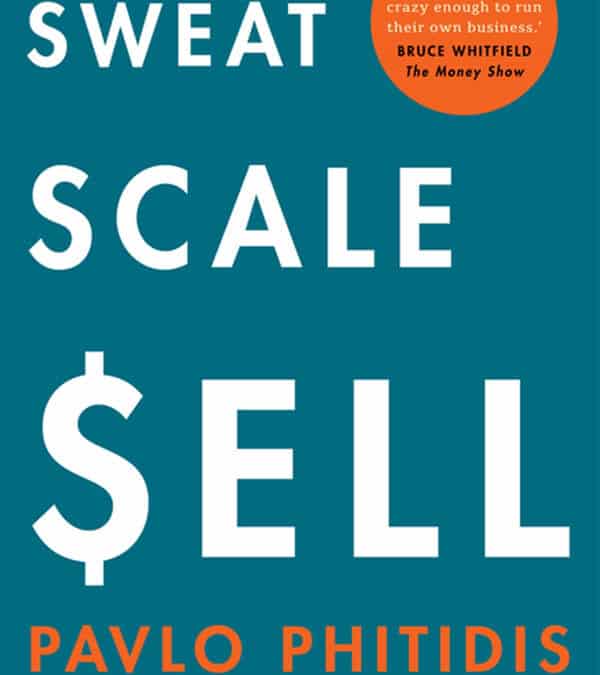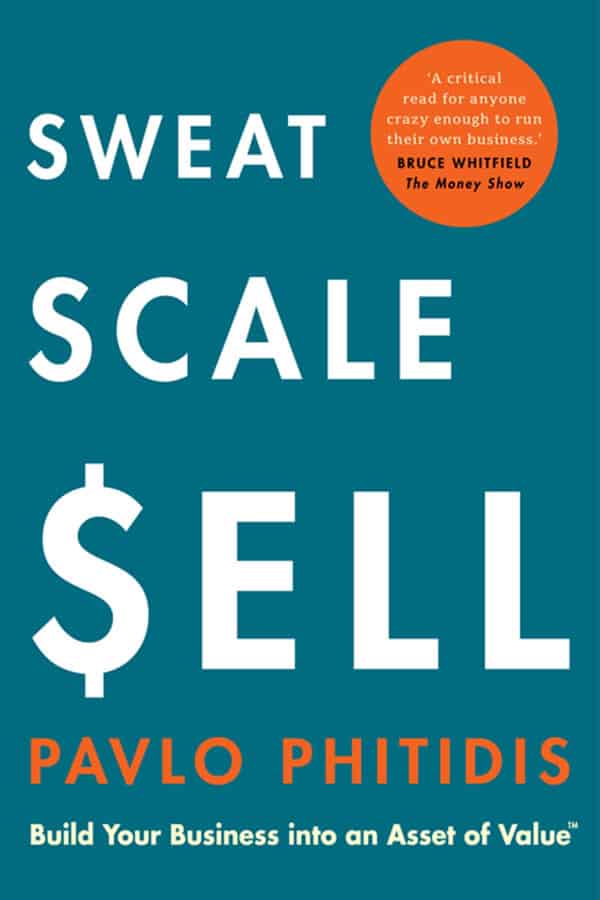Sweat, Scale, Sell, Build Your Business into an Asset of Value by Pavlo Phitidis
Recommendation
Many entrepreneurs invest so much heart and soul into their businesses, only to see their creations wither away. Even the rare few who build successful companies often fail to create a structure that outlives their involvement. But it doesn’t have to be that way, argues Pavlo Phitidis, a seasoned entrepreneur and business coach. This engaging guide lays out his principles for growing an enterprise into an “Asset of Value.” His advice is simple and straightforward, but Phitidis, to his credit, acknowledges that building a salable company is never painless – it requires hard work and constant vigilance.
Take-Aways
- Small- and medium-sized-business owners are the heroes of the global economy.
- Not all thriving businesses become an “Asset of Value.”
- In many ways, managing a company is like being the captain of a ship.
- Too much complexity can sabotage a leader’s efforts.
- A well-functioning “System of Delivery” fits a business’s building blocks together.
- For entrepreneurs, having the right crew is critical.
- Owners should never underestimate the importance of their expertise.
- Systems unlock the time needed to grow a business strategically.
Sweat, Scale, Sell Book Summary
Small- and medium-sized-business owners are the heroes of the global economy.
Entrepreneurs dream big and take risks – mostly without government handouts or public subsidies. Yet many small- and medium-sized-business owners, despite the blood, sweat and tears invested in their enterprises, manage to build only short-lived operations. Business failures are a global epidemic. Even in the United States, the world’s most robust environment in which to start and run a company, the Internal Revenue Service estimates that nearly 95% of all businesses wind down without selling.
““Businesses close at tremendous cost to owners and their families, staff, suppliers and customers.””
The fact that a vast majority of enterprises never gain new ownership reveals that most entrepreneurs are pursuing a flawed system of business-building. They should instead adopt an “Asset of Value” approach: focusing on creating a profitable business that continues to run well once its founder leaves the scene.
Not all thriving businesses become an asset of value.
Many entrepreneurs are micromanagers who become slaves to their businesses. Rather than putting systems in place, they hurriedly tend to every need of their operations. The inevitable result is a fatal blow to salability: No right-minded investor wants to buy a company that relies almost entirely on the effort and expertise of one person.
““You cannot be an expert on all the elements required to make a business successful.””
Clive was a thriving entrepreneur in his 60s when the author took him on as a client. Clive had built a profitable South African IT company with 68 employees, but the business consumed him. He didn’t know how to delegate, and he was involved in nearly every decision. After Clive suffered a heart attack, he decided to change. He brought his wife in to handle administrative tasks while he focused on technical challenges.
““When your business cannot function without you, you don’t have a business, you have a job. How do you sell a job?””
One day, a rival made a surprise visit and confessed that he had been trying to take down Clive’s company for years. His efforts had failed, so the competitor offered to buy Clive’s firm. Clive demanded a steep price, and the buyer seemed to agree. However, at the closing table, Clive learned he would not receive the whole sum at once; he would have to stay on with the business for three years and report to a boss. He turned the offer down. Phitidis helped Clive see the problem he had created for himself: Clive’s company couldn’t operate without him. He was stuck. The firm’s worth hinged on Clive’s involvement, so it wasn’t an asset of value.
In many ways, managing a company is like being the captain of a ship.
An effective ship is built for its purpose – an oceangoing vessel is designed differently from one that traverses flat water. To remain seaworthy, a ship must receive regular cleaning and maintenance. Its captain must also ensure tight management of its crew. In the same vein, business owners must fine-tune their operations, time and again. The best managers routinely adjust processes, shift staff, and hone communications with employees and clients.
““Like a ship, a business needs to be constantly maintained.””
The faster a company grows, the more constant vigilance it requires. Phitidis learned this lesson while running a mobile phone company that sold ringtones, wallpaper and other add-ons. Revenue soared, but the business needed reinvention almost every month, lest it morph into an unwieldy, unmanageable mess. The author saw himself as the captain on the bridge. He set the overall direction and gave orders to the crew, who executed the many tasks required to keep the vessel moving smoothly. The bigger the boat (or business), the more complex it is to operate, which is why well-run ships have clear descriptions of jobs that demand expertise in specific areas.
Whether on a ship or in a business, the delineation of duties and the chain of command are vital. Back to the example of Clive: He was his company’s captain, yet he didn’t spend enough time on the bridge setting the overall direction of the business. He was metaphorically swabbing decks and repairing engines when he should have delegated those jobs to others.
““When building an Asset of Value, the path you take to reach your destination port will undoubtedly change due to unpredictable seas, storms, wind and currents.””
A salable company is one that relies on a variety of systems. With systems in place for marketing, customer service, lead generation and other functions, the owner can focus on the big picture. Leaders must realize that their actual value lies in the critical decisions made on the bridge. That’s where Clive should have spent at least 60% of his working hours.
Too much complexity can sabotage a leader’s efforts.
Jack, a baker, built an impressive, multidimensional business that made more than ZAR50 million ($2.7 million) in annual revenue. He supplied flour to bakeries, sold baking equipment to a major supermarket chain, and operated retail outlets that combined a coffee shop and bakery in the same store. He also furnished fresh-baked goods to hotels. When Jack approached Phitidis, he had two gripes: First, he was trying to sell his company, but it had languished on the market for two years without a bid. Second, he was stuck at the same level of revenue, unable to grow.
““Trying to be everything to everyone makes you nothing to no one.””
As with Clive’s firm, Jack’s business relied too much on the knowledge and effort put forth by its founder. What’s more, Jack’s operations were too unwieldy to attract buyers. At first, he resisted the notion that he needed to simplify. Closing down one of his many lines of business would mean giving up customers. Jack had learned about the importance of having paying customers the hard way: Early on, he often made month-end payrolls only by delivering croissants directly to clients’ homes.
““Serving every customer and opportunity that crosses your path will result in a lack of clarity in what you do and cause chaos in your operations.””
Still, Jack decided to follow Phitidis’s advice. He sold the silos that stored flour, divested a couple of his retail stores and stopped working with supermarkets. By focusing solely on supplying hotels with baked goods, Jack was able to maintain the same annual profits, even though his sales plummeted. Jack’s lesson is a valuable one for all entrepreneurs: It’s tempting to serve every customer who walks through the door, but unless those clients boost profits, the savvy business owner must be willing to let them go.
A well-functioning “System of Delivery” fits a business’s building blocks together.
Even after simplifying his company, Jack still found himself continually jumping in to work on routine tasks. Like Clive’s, Jack’s business lacked systems. A ship cruises to its destination thanks to its design and crew working together. By the same token, a business achieves its goals via its integrated operations – that is, its system of delivery.
““In an Asset of Value, each system has to run smoothly to produce consistent forward motion by delivering a reliable customer experience as defined by your business’s positioning.””
The system of delivery’s first part is marketing. Every business needs new customers, so a lead-generation system is crucial. In Jack’s case, this took the form of email campaigns to potential clients. Hotel food managers received promotions about croissants and other tasty creations; hotel finance managers got a pitch focused on cost savings. Jack sent these emails and recorded his response rate. Then he tweaked the messages and repeated the process.
Generating leads is just step one. Someone has to convert those leads into paying customers; this is where sales systems enter the picture. A sales system relies on a coherent story that salespeople can tell prospects. Creating a simple, clear script for salespeople is not an easy task, but with a sales system in place, Jack was able to boost orders. The marketing message and the sales system must match.
““When the sales process aligns to the marketing message and promise, the sales engagement equals your customer’s expectation.””
Building a smoothly operating system of delivery is quite a feat – so much so that business owners often find themselves searching for prefabricated solutions, such as those promised by enterprise resource planning (ERP) software. Unfortunately, most discover, as Jack did, there really is no good shortcut to a well-functioning system of delivery. Off-the-shelf systems can’t compare to those a business owner builds, piece by piece, based on his or her in-depth understanding of the firm’s specific operations, goals and problems.
For entrepreneurs, having the right crew is critical.
Understanding workers, motivating them, and keeping them on task and in the company are all significant challenges. Many owners follow the old hiring model of posting a job description on the internet, conducting an interview and hoping for the best. But employees need a framework if they are to succeed. A founder can’t recruit a salesperson and a marketing manager and then just leave them to their own devices, expecting them to perform well. Instead, an owner should set up a system for the salesperson and marketing manager to follow.
““Building systems first and employing people to operate those systems next is the most profitable and certain route to ensuring a steady, consistent seafaring journey toward your destination.” ”
The notion of hiring people to work a well-honed system is a simple concept, but one that eludes many entrepreneurs. Oren, a tech executive, hired several promising executives but grew frustrated when they couldn’t perform as he expected. Oren’s hires would have been capable of doing the job – if they’d received some guidance and support. Instead, Oren handed them the positions and then ignored them. His hires were competent and willing to work, but his practice of throwing them into roles without systems sabotaged their efforts.
Owners should never underestimate the importance of their expertise.
Delegation is an essential skill for bosses, but that doesn’t mean they shouldn’t know how to do things. The author learned this lesson as a college student in a grueling building services program. Phitidis’s professor recognized that his pupil wasn’t suited for a corporate job; he was a born entrepreneur. So the teacher assigned Phitidis to spend a summer of hard labor doing all manner of construction jobs – digging foundations, putting up walls, installing roofs. When Phitidis protested, the professor offered a bit of wisdom: “How do you propose to employ your staff if you have never built anything with your hands first?”
““Having a good crew to help you sail your ship means getting the right people to do the right thing at the right time at the right price.” ”
Phitidis relearned the lesson when he started a company based on an app. He didn’t know how to code, so he hired a team of developers to handle that task. He soon grew impatient with the slow pace of work. Phitidis bought a book on programming language and taught himself the rudiments of coding. He wasn’t skilled enough to work as a programmer, but after his studies, he knew enough to engage in meaningful conversations with the coders, which vastly improved their working relationship.
Systems unlock the time needed to grow a business strategically.
Jack once confided to Phitidis that he used to spend his days in a constant frenzy. He was engaged in every aspect of the business, and he was “busy being busy.” Many entrepreneurs think that constantly responding to emergencies is precisely what they ought to be doing, but their true role is to steer the ship – to create a vision and then implement it.
““As business owners, because we are always working on, thinking about and busy in our businesses, we seldom pause to understand how to quantify and value our time.””
Always-on CEOs might feel fulfilled at first: After all, their companies rely on them. Over time, however, most entrepreneurs tire of the constant scramble, and they begin to resent the business. By building systems which allow them to stop acting as firefighters, leaders can embrace their broader purpose and the enterprise can truly accelerate. Once an owner is working on the business, rather than working in the business, he or she can take time to analyze broader trends and understand how those factors might affect sales. Leaders can then strategically expedite growth.
““Accelerated growth is only of any value if your revenue increases while your costs do not increase significantly.””
Only when an efficient, systematized operation is in place can the entrepreneur be sure of receiving serious offers for his or her creation. Potential buyers consider three factors: First, how long, in years, can the company operate without the founder acting as captain of the ship? The higher this number, the more valuable the company. A typical answer is three years. Second, how much free cash flow does the business churn out? Again, the higher this number, the higher the valuation. The third variable is the discount rate: the net present value of the cash flow, calculated according to the buyer’s forecast period of future operation. The discount rate captures the risk level of the buyer’s investment, and often comes in between 18% (low risk) and 45% (high risk).
Sales of a business can take several forms, including selling a firm for cash or for shares, having current team members buy the business, or transferring ownership to family members. But all too often, an enterprise simply ceases to exist. Clearly, producing and steering a viable business requires fervor, fortitude and creativity.
About the Author

Pavlo Phitidis is an entrepreneur and investor with 25 years of experience in building businesses across four continents. He runs Aurik Business Accelerator in South Africa.


